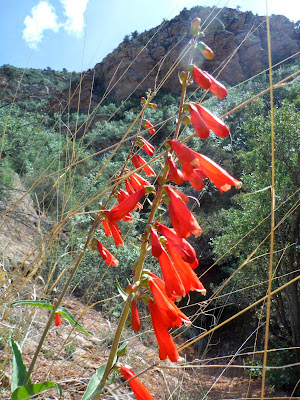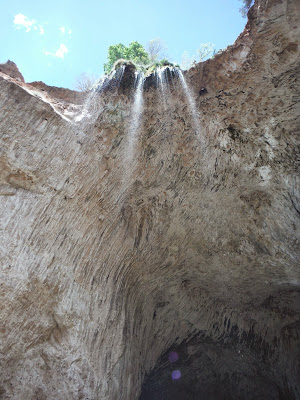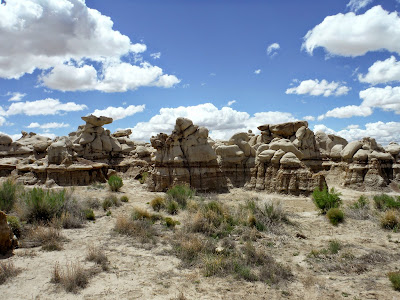Sangre de Cristo Mountains, NM
Day 13
4.26.15
April 26th, day 13 of my trip, I woke to an interesting weather forecast. Snow. Snow in New Mexico, on the eastern slopes of the Sangre de Cristo Mountains. Timing was hard to figure out from an audio forecast, so I was living on the edge since the morning. In Mills Canyon, I had some high cirrostratus clouds, which is typically a sign of some incoming storm. The weather was still fair, so I planned my route during breakfast on the glorious picnic table.
I had no specific plan as far as an endpoint, but I certainly didn't want to go outside New Mexico, having experienced how long it took to get anywhere in the state yesterday. In preparation for this trip, I had starred a few places in NM to see, one of which being Wheeler Peak, the highest point in the state. Where I was currently, Wheeler Peak was only 150 miles away, though any chance of hiking it was shot with impending snow, as well as waking up too late to actually drive there, and have enough time to hike. However, I still wanted to see it, so I decided on Bobcat Pass, which is a road that drives around the north side of the mountain.
With everything packed up, I proceeded to get a closer look at the canyon walls before leaving the site. The ground was very soft, filled with cacti and pokey bushes. Nevertheless, I made my way to the walls.
 |
| The view toward the west wall of the canyon |
 |
| Holy walls. (The power of Jesus?) |
I was considering going a bit further up the wall where possible, but the rock was way more crumbly than expected, so that ended quickly, as I wanted to be able to get down without tumbling into a cactus-field. Instead, I took a closer look at some of the rocks.
 |
| Ultra holy walls. |
After walking back to the campsite, I snapped this picture of the east canyon wall. I love how fluid it looks.
 |
| East canyon wall |
I was ready to leave the site and head up the 2-mile ascent up the rough road to the top, but I wanted to briefly check out some of the other dirt roads on the canyon basin. Not more than 5 minutes in, I was going through some ruts, and a heard a horrible snap under the car. Perfect. Glad to have AAA coverage. I pulled past the rut to flat ground, since nothing was collapsed on the car, so I could look underneath. The piece in the picture below was hanging by the rubber linkage on the right side, and I pulled out the tools to try and remove it since I didn't want it hanging down while I was driving. That was a failure, since everything was all rusted together. I determined that it wasn't a crucial piece to holding the wheel on, so I figured I better keep driving and see what happens. Ten seconds later, the rubber linkage snapped too, so the piece was detached. That
is what I wanted, right?
 |
| My sway bar and where it ought to be... |
Well, it turns out I made it out of the canyon, and 100 miles further, fine with no issues. Thanks to the smart people on the Subaru Facebook group, I learned that this is my precious sway bar. Its purpose is to control body roll while cornering at higher speeds. Some cars have these and others don't. Without it, I technically have a fully independent front suspension, which is ideal for off-roading since it provides a bit more flexibility for dealing with uneven terrain. I consider it a favorable modification. Wombat, welcome to Phase II of your life!
 |
| Urban New Mexico |
I thought I lived in rural Maine. Rural Maine is extremely developed compared to rural New Mexico. There is nothing for miles and miles and miles. Just straight roads. Again, I passed through these "towns" that involved not much more than a crossroads, and a building or two if you're lucky.
Finally, I made it to a civilization that provided me with some petrol, for my thirsty tank. I believe this was Springer, NM. I continued west to challenge the Rocky Mountains with a full tank. I was following scenic drives according to my atlas, with roads like Rt. 199, Rt. 21, and US-64. Somewhere along this stretch, I was driving along, looking in awe at the mountains that were rising up above me.
Then what I thought to be a gazelle tried to commit suicide via my car. I saw all of this peripherally, so take it with a grain of salt. I believe it was on the left side trying to cross the road, realized I was in the way, and decided to race me instead. Mission aborted and pseudo-gazelle returned to the left side of the road. I thought it was going to hit me, but we were both very lucky. After a New Mexican mammal search, I deduced that it was either an oryx or a pronghorn antelope. I believe it had straight horns, so I'm going with the oryx. (Sorry no pics, was trying to win the race.)
 |
| US-64 west heading toward Wheeler Peak |
The beautiful Sangre de Cristo Mountains began to rise around me as I moved west. US-64 passes through Cimarron Canyon State Park, which is different from all the canyons I have seen so far. This one appeared to be made of metamorphic rocks, where the rock is transformed from pre-existing rock via extreme temperature or pressure. These rocks often form vertical flumes and look like a fluid that got frozen in time, then chunks broke off. I had to pull over to get a close look, since the walls were so high I couldn't see the top from inside the car.
 |
| Cimarron Canyon SP, north wall |
During this part of the day, I was seeing some intermittent blue sky patches, though some of the roads were wet, indicating there had been some precipitation. I wasn't sure where and when this snow was, but I was on the lookout.
I turned north onto Rt. 38, and started the climb up to Bobcat Pass, the highest mountain pass in the state of New Mexico. This road was filled with tight twisties as well as some sweepers. This was when I really began to notice the lack of engine power. At sea level, the air is dense with oxygen, and you get the right air-fuel mixture, but up over 9000 feet, the air is less dense, and you end up with a gasping engine that needs to rev super high to have any power to climb the hills. Once I got the Bobcat Pass, I got out to take the picture, and did so very quickly because the temperature up here was very cold (probably 40s or so, compared to 70s down in Mills Canyon).
 |
| Bobcat Pass! 9820' above sea level |
Soon after going over the pass, I saw a gravel drive that went up a hillside, and I hoped that would have a better view of Wheeler Peak, the mountain I drove here to see. I couldn't have been more satisfied. This road climbed over 10,000', presumably a first for Wombat. The snowcapped peak stood guard over the range, nearly luring me to come climb it. Perhaps some other day.
 |
| Wheeler Peak, 13,159' |
The descent from the pass began, with some dramatic views around every bend. Unfortunately there were these concrete barriers everywhere. Maybe you think they are beautiful. In which case, you'll love this photo:
 |
| Stunning concrete barriers, with some irritating mountainside carved out behind. |
I came down into the ski town of Red River, NM. I pulled off here on a whim, since I saw a sign for the library, and we all know that's how Nathan gets internet along the trip. It was a pretty town, and here is where I discovered all there is to know about sway bars.
Not long after, I heard some thunder, which was very exciting at this high elevation among the hills of giants. It began to rain, and then it began to do something that wasn't rain, and also wasn't quite snow. It was like small white balls of soft ice. It became very heavy, extremely blowy outside, and covered everything with a layer of white.
 |
| "Snow" in Red River, NM |
After it calmed down a bit, I continued down the road, and saw my first flock of bighorn sheep, calmly browsing along the edge of the road.
 |
| Bighorn sheep along Rt. 38 |
By here, I decided I should probably look for a place to aim for by evening, so I chose the highest state capital in the US: Santa Fe, at 7200 feet! Relatively close, considering all the stops I had made just to enjoy the mountains. While following some more mountain roads toward Santa Fe, I found a new road sign I haven't seen before:
 |
| Complete S-curve ahead. |
While entering the general area of Santa Fe, I saw a fair amount of these awesomely decorated bridges. I assume this is the outcome of the Native American culture that is so prevalent in NM. Lots of cool art and stuff made from mud and stucco, etc.
Once in the city, I went to the ends of the Earth to find free parking. For those in need, Otero St. has free parking for people on Sundays. If it's 8am-6pm Mon-Sat, and you don't live on the street, you WILL be towed. Luckily this wasn't too far away from some nice streets downtown to walk along. I decided I was going to check out places that serve you food instead of pulling out the camp stove and the coolers. I found a neat place called Rooftop Pizzeria. It was nice to settle down and not drive for awhile.
After dinner, I brought my car into the library parking lot for some catchup. As you may recall, I wrote a few posts from that very parking lot. I also debated for awhile where I would be camping for the night, and I chose a place that was only about 20 miles away. What I didn't realize was that this place was deep into the mountains. At 11,000 feet. Recall the forecast for snow? Well if it was anywhere, it would certainly be there. As I drove up the mountain, I got glimpses of the city lit up, which was truly a spectacular sight. With as much incline as there was, and at this elevation, I was struggling to get the car to go any faster than 25mph. Though that was acceptable since the radius of the turns around here was microscopic.
This place was supposed to be a ski area, but in the off season, you can camp there for free. That would be assuming you can find the places to camp. I arrived there in the dead of night, snow covering the mountainside, and half the parking lot. I pull in, and wander around aimlessly again, like I did in Oklahoma. It was in fact snowing here. Perfect. This is when I started to notice the effect of the elevation on my own breathing. Normally walking across a parking lot is not challenging. At 11k, I did notice myself out of breath. That was a strange and exciting experience.
I found a place off the parking lot a bit, with a few inches of snow cover. I set up the tent and camping stuff, then turn my weather receiver on. "Sunday night, periods of heavy snow, accumulation around 5-10 inches, up to 15 locally." This was not exactly what I had planned for. I mean I could stay warm, but who knows if they plow the road up here in late April? It would be a true test of Subaru AWD. The only good news is that the winter storm warning was primarily for the eastern slopes of the mountains, and I was on the western slopes. I went to grab the ice scraper from the car, so I would have it to use in the morning if need be.
I began to write in the journal, and of course the most comforting thing happened: a coyote frenzy that seemed way too close for anybody to want to be camping alone in a tent, 10 miles from civilization. I'm not very easily scared, but this definitely increased the readout on my terror-ometer. Luckily I did not get eaten that night. Or if I did, I have been in a strangely realistic afterlife since then, and I'm also on a road trip across America. And everyone I know is also in the afterlife?...
I set the alarm for 5am just in case there was 15" of snow. Earlier would be better than later as far as escaping from the mountains successfully. We shall see in the next post what happened. Also pictures.
EDIT: I always do this...I've forgotten to put the progress map in. Miles to date: 3662. Here y'all go:
 |
| 260 miles of glorious mountain roads |
EDIT: For those interested, this is what an oryx looks like:

























































